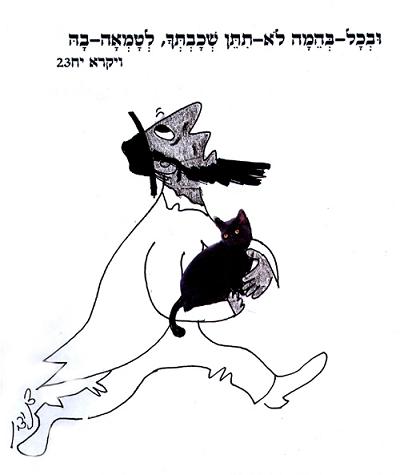
Once a sage saw a cat bite off an infant’s hand. After this tragic incident the sages ruled that one may not raise a cat and that one must even kill it as a menace. The scholars asked: Did not Rabbi Shimon the son of Elazar suggest that one may raise a cat? The sages settled the contradiction by saying that there is a difference between a black cat and a white cat. A white cat is accustomed to harming people and therefore one is forbidden to raise it, as the sages ruled, but a black cat may be raised, in keeping with the opinion of Rabbi Shimon the son of Elazar. The scholars continued to raise questions: the tragic incident which caused the sage to order the cat’s death involved a black cat! If so, why did he call for the cat’s death? The scholars were answered: Though the cat was black, it was the son of a white cat. The scholars continued and asked: Did not Ravina, one of the Babylonian sages, ask whether a black cat sired by a white cat must be killed? They answered the scholars: Ravina’s question was about a black cat sired by a white cat which had been sired by a black cat. (But if the black cat had been sired by a white cat who in turn had been sired by a white cat, one is forbidden to raise it and must kill it. This was the background of the cat involved in the tragic incident.)
(Babylonian Talmud, Tractate Bava Kama 80b)
The Talmudic text:
Samuel would not enter before Rav Assi, nor Rav Assi before Rav. They therefore argued who should go in last, [and it was decided that] Samuel should go in last, and that Rav and Rav. Assi should go in [together]. But why should neither Rav nor Rav Assi have been last? — Rav [at first] was merely paying a compliment to Samuel, to make up for the [regrettable] occasion when a curse against him escaped his lips; for that reason Rav offered him precedence. Meanwhile a cat had come along and bitten off the hand of the child. Rav thereupon went out and declared in his discourse: “It is permissible to kill a cat, and it is in fact a sin to keep it, and the law of robbery does not apply to it, nor that of returning a lost object to its owner.” Since you have stated that it is permissible to kill it, why again state that it is a sin to keep it? You might perhaps think that though it is permissible to kill it, there is still no sin committed in keeping it; we are therefore told [that this is not so]. I could still ask: Since you have said that the law of robbery does not apply to it, why again state that the law of returning a lost object to its owner does not apply to it? Said Ravina: This refers to the skin of the cat [where it was found dead]. An objection was: R. Shimon the son of Elazar says: It is permissible to breed village dogs, cats, apes and porcupines, as these help to keep the house clean. There is, however, no contradiction, as the latter teaching refers to black cats, whereas the former deals with white ones. But was not the mischief in the case of Rav done by a black cat? In that case it was indeed a black cat, but it was the offspring of a white one. But is not this the very case about which Ravina raised a question? For Ravina asked: What should be the law in the case of a black cat which is the offspring of a white one? The problem raised by Ravina was where the black was the offspring of a white one which was in its turn a descendant of a black cat, whereas the accident in the case of Rav occurred through a black cat which was the offspring of a white one that was similarly the offspring of a white cat.
